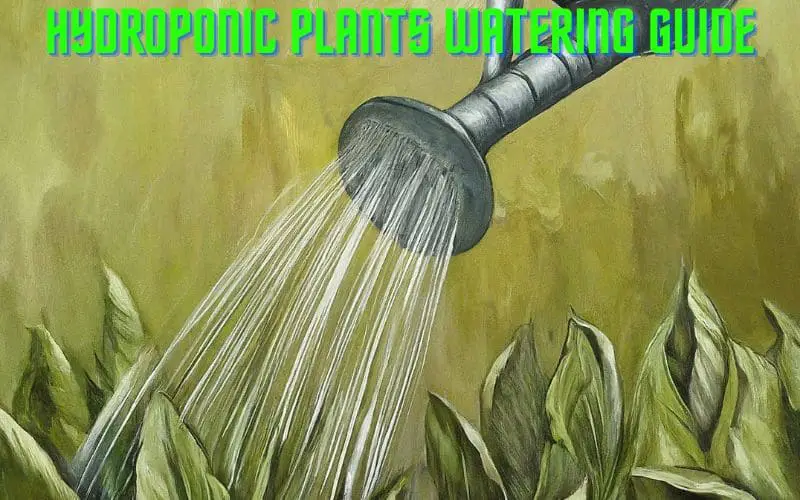Hydroponic Plants Watering Guide: 4 Essential Tips

Introduction
When it comes to growing hydroponic plants, one of the essential elements for their success is proper watering. In this guide, we’ll explore the crucial tips and techniques for watering your hydroponic plants to maximize their growth and health. So, grab your watering can, and let’s dive into the world of hydroponic plant watering!
Choosing the Right Hydroponic System
Explore Different Hydroponic Systems
- Deep Water Culture (DWC): This hydroponic system involves suspending plant roots in a nutrient solution. It’s a simple system and is ideal for growing lettuce, spinach, and herbs.
- Nutrient Film Technique (NFT): In this system, a thin film of nutrient solution flows along the bottom of the channel where plant roots are suspended. NFT is suitable for growing smaller, quick-growing plants like lettuce and herbs.
- Ebb and Flow (Flood and Drain): This system involves flooding the plant roots with nutrient solution and then draining it back into a reservoir. It’s versatile and can accommodate a wide range of plant types.
- Aeroponics: Plant roots are suspended in the air, and a fine mist of nutrient solution is sprayed directly onto the roots. Aeroponics is highly efficient and suitable for plants that require high oxygen levels.
Before delving into watering techniques, it’s important to choose the right hydroponic system for your plants. Each type of hydroponic system has its advantages and unique watering requirements. For example, some systems may be more suitable for small, quick-growing plants, while others may be better for larger, fruiting plants. Consider the space you have available, the types of plants you want to grow, and your overall goals when selecting a hydroponic system.
Monitoring Nutrient Levels
Measuring and Adjusting Nutrient Levels
Aside from water, hydroponic plants rely on a carefully balanced nutrient solution for optimal growth. Learn how to measure and adjust the nutrient levels in your system to ensure that your plants receive the essential elements for healthy development. Maintaining proper nutrient levels is key to supporting vigorous plant growth and overall health.
Creating a Watering Schedule
Establishing a Consistent Watering Schedule
Consistency is vital when it comes to watering hydroponic plants. A well-planned and consistent watering schedule is essential for promoting healthy growth and development of your plants. Here are some important factors to consider when establishing a reliable watering schedule:
- Plant-Specific Needs: Different plants have varying water requirements based on their species, size, and stage of growth. Research and understand the specific watering needs of each type of plant in your hydroponic system.
- Growth Stage: As plants progress through different growth stages, their water requirements change. For example, young seedlings may need more frequent, smaller waterings, while mature plants require less frequent but more substantial waterings.
- Environmental Factors: Consider the temperature, humidity, and airflow in the growing environment as they can affect the rate at which plants absorb water. Adjust your watering schedule to accommodate these environmental variables.
- Water Quality: Pay attention to the quality of water used in your hydroponic system. Factors such as pH levels, dissolved solids, and contaminants can impact how effectively plants uptake water and nutrients.
By tailoring your watering schedule to match the specific needs of your plants and environmental conditions, you can promote robust root development and overall plant health. Consistency in watering not only facilitates optimal growth but also plays a key role in preventing water-related issues that may affect the well-being of your plants. A well-regulated watering schedule contributes to the sustainable success of your hydroponic garden.
Checking pH Levels
Importance of Maintaining Proper pH Levels
The pH level of the nutrient solution directly impacts the availability of essential nutrients to your hydroponic plants. Maintaining proper pH levels is critical for the overall health and growth of your plants. Here are some key points to consider:
- Optimal pH Range: Different plant varieties thrive in specific pH ranges. For example, most vegetables grow best in a pH range of 5.5 to 6.5, while strawberries prefer a slightly lower pH of 5.0 to 6.0.
- Nutrient Uptake: When the pH strays outside the optimal range, essential nutrients become less available to the plants. This can lead to deficiencies, stunted growth, and poor fruit development.
- pH Stability: Fluctuations in pH can disrupt the balance within the hydroponic system, leading to stress on the plants. Maintaining stability through proper monitoring and adjustments is crucial for the well-being of the plants.
Ensuring proper pH levels is not only about providing the right conditions for nutrient absorption but also plays a significant role in preventing the onset of disease and pest infestations. By understanding the ideal pH ranges for different plant varieties and implementing effective techniques for maintaining pH stability, you can promote healthy growth and optimize the yield of your hydroponic plants.
Conclusion
As we conclude our exploration of hydroponic plant watering, remember that successful plant growth starts with a solid foundation in proper watering techniques. By choosing the right system, monitoring nutrient levels, creating a consistent watering schedule, and checking pH levels, you can set the stage for lush, healthy hydroponic plants that thrive in their soilless environment. Now, it’s over to you! How will you enhance the watering practices for your hydroponic plants?
